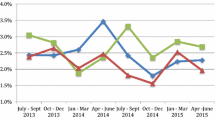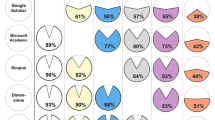Abstract
There are often differences in a publication’s citation count, depending on the database accessed. Here, aspects of citation counts for medical physics and biomedical engineering papers are studied using papers published in the journal Australasian physical and engineering sciences in medicine. Comparison is made between the Web of Science, Scopus, and Google Scholar. Papers are categorised into subject matter, and citation trends are examined. It is shown that review papers as a group tend to receive more citations on average; however the highest cited individual papers are more likely to be research papers.


Similar content being viewed by others
References
Baldock C, Ma R, Orton CG (2009) The h index is the best measure of a scientist’s research productivity. Med Phys 36(4):1043–1045
Baldock C (2008) The h-index and medical physics. Australas Phys Eng Sci Med 31(2):xi–xii
Butson MJ, Yu PKN (2010) The first author h-index (hfa-index): levelling the field for small and large institute medical and science scholars. Australas Phys Eng Sci Med 33(4):299–300
Hirsch JE (2005) An index to quantify an individual’s scientific research output. Proc Natl Acad Sci USA 102(46):16569–16572
Egghe L (2006) Theory and practise of the g-index. Scientometrics 69(1):131–152
Schubert A, Braun T (1986) Relative indicators and relational charts for comparative assessment of publication output and citation impact. Scientometrics 9(5):281–291
Schubert A, Braun T (1996) Cross-field normalization of scientometric indicators. Scientometrics 36(3):311–324
Radicchi F, Fortunato S, Castellano C (2008) Universality of citation distributions: toward an objective measure of scientific impact. Proc Natl Acad Sci USA 105(49):17268–17272
ARC (2015) State of Australian University Research 2015-16, Commonwealth of Australia. http://era2015.arc.gov.au/index.html
Caon M (2009) APESM joins Springer stable. Australas Phys Eng Sci Med 32(4):XIII
Clarke K (2007) An historical perspective of the APESM. Australas Phys Eng Sci Med 30(1):XIV–XV
Beddoe A (2007) Reminiscences on APESM in the Post-Clarkean epoch and some hints to potential authors. Australas Phys Eng Sci Med 30(2):XIV–XVI
Vafaeyan H, Ebrahimzadeh SA, Rahimian N, Alavijeh SK, Madadi A, Faeghi F, Harirchian MH, Rad HS (2015) Quantification of diagnostic biomarkers to detect multiple sclerosis lesions employing 1H-MRSI at 3T. Australas Phys Eng Sci Med 38(4):611–618. doi:10.1007/s13246-015-0390-1
Chen M, Elazab A, Jia F, Wu J, Li G, Li X, Hu Q (2015) Automatic estimation of midline shift in patients with cerebral glioma based on enhanced voigt model and local symmetry. Australas Phys Eng Sci Med 38(4):627–641. doi:10.1007/s13246-015-0372-3
Round WH et al (2015) Brief histories of medical physics in Asia-Oceania. Australas Phys Eng Sci Med 38(3):381–398. doi:10.1007/s13246-015-0342-9
Ghahraman Asl R, Nasseri S, Parach AA, Zakavi SR, Momennezhad M, Davenport D (2015) Monte Carlo and experimental internal radionuclide dosimetry in RANDO head phantom. Australas Phys Eng Sci Med 38(3):465–472. doi:10.1007/s13246-015-0367-0
Round WH, Stefanoyiannis AP, Ng KH, Rodriguez LV, Thayalan K, Han Y, Tang F, Fukuda S, Srivastava R, Krisanachinda A, Shiau AC, Deng X (2015) AFOMP policy no 5: career progression for clinical medical physicists in AFOMP countries. Australas Phys Eng Sci Med 38(2):217–221. doi:10.1007/s13246-015-0355-4
Geethanjali P (2015) Comparative study of PCA in classification of multichannel EMG signals. Australas Phys Eng Sci Med 38(2):331–343. doi:10.1007/s13246-015-0343-8
Wong KKL, Chu WCW (2015) Ethics policies and procedures in imaging and interventional radiology. Australas Phys Eng Sci Med 38(2):375–376. doi:10.1007/s13246-015-0346-5
Chalkia MT, Stefanoyiannis AP, Chatziioannou SN, Round WH, Efstathopoulos EP, Nikiforidis GC (2015) Patient-specific dosimetry in peptide receptor radionuclide therapy: a clinical review. Australas Phys Eng Sci Med 38(1):7–22. doi:10.1007/s13246-014-0312-7
Baig MM, GholamHosseini H, Connolly MJ (2015) Mobile healthcare applications: system design review, critical issues and challenges. Australas Phys Eng Sci Med 38(1):23–38. doi:10.1007/s13246-014-0315-4
Moutrie V, Kairn T, Rosenfeld A, Charles PH (2015) Use of a megavoltage electronic portal imaging device to identify prosthetic materials. Australas Phys Eng Sci Med 38(1):93–100. doi:10.1007/s13246-015-0327-8
Yu L, Poole CM, Lancaster CM, Sylvander SR (2015) Towards online patient imaging during helical radiotherapy. Australas Phys Eng Sci Med 38(1):119–128. doi:10.1007/s13246-015-0331-z
Amin HU, Malik AS, Ahmad RF, Badruddin N, Kamel N, Hussain M, Chooi WT (2015) Feature extraction and classification for EEG signals using wavelet transform and machine learning techniques. Australas Phys Eng Sci Med 38(1):139–149. doi:10.1007/s13246-015-0333-x
Rezaei F, Hassani K, Solhjoei N, Karimi A (2015) Carbon/PEEK composite materials as an alternative for stainless steel/titanium hip prosthesis: a finite element study. Australas Phys Eng Sci Med 38(4):569–580. doi:10.1007/s13246-015-0380-3
Ghaffari A, Mollakazemi MJ, Atyabi SA, Niknazar M (2015) Robust fetal QRS detection from noninvasive abdominal electrocardiogram based on channel selection and simultaneous multichannel processing. Australas Phys Eng Sci Med 38(4):581–592. doi:10.1007/s13246-015-0381-2
Ahmadvand A, Sharififar M, Daliri MR (2015) Supervised segmentation of mri brain images using combination of multiple classifiers. Australas Phys Eng Sci Med 38(2):241–253. doi:10.1007/s13246-015-0352-7
Bashir S, Qamar U, Hassan F (2015) Bagmoov: a novel ensemble for heart disease prediction bootstrap aggregation with multi-objective optimized voting. Australas Phys Eng Sci Med 38(2):305–323. doi:10.1007/s13246-015-0337-6
Kairn T, Charles PH, Cranmer-Sargison G, Crowe SB, Langton CM, Thwaites DI, Trapp JV (2015) Clinical use of diodes and micro-chambers to obtain accurate small field output factor measurements. Australas Phys Eng Sci Med 38(2):357–367. doi:10.1007/s13246-015-0334-9
Hosain MK, Kouzani AZ, Tye S, Kaynak A, Berk M (2015) RF rectifiers for EM power harvesting in a deep brain stimulating device. Australas Phys Eng Sci Med 38(1):157–172. doi:10.1007/s13246-015-0328-7
Smith RL, Panettieri V, Lancaster C, Mason N, Franich RD, Millar JL (2015) The influence of the dwell time deviation constraint (DTDC) parameter on dosimetry with IPSA optimisation for HDR prostate brachytherapy. Australas Phys Eng Sci Med 38(1):55–61. doi:10.1007/s13246-014-0317-2
Dowling JA (2014) Opportunities for image analysis in radiation oncology. Australas Phys Eng Sci Med 37(2):275–277
Pogson EM, Begg J, Jameson MG, Dempsey C, Latty D, Batumalai V, Lim A, Kandasamy K, Metcalfe PE, Holloway TC (2015) A phantom assessment of achievable contouring concordance across multiple treatment planning systems. Radiother Oncol 117(3):438–441. doi:10.1016/j.radonc.2015.09.022
Robb RA, Hanson DP (1991) Software system for interactive and quantitative visualization of multidimensional biomedical images. Australas Phys Eng Sci Med 14(1):9–30
Keall PJ, Kini VR, Vedam SS, Mohan R (2002) Potential radiotherapy improvements with respiratory gating. Australas Phys Eng Sci Med 25(1):1–6
Keall P, Baldock C (1999) A theoretical study of the radiological properties and water equivalence of Fricke and polymer gels used for radiation dosimetry. Australas Phys Eng Sci Med 22(3):85–91
Butson MJ, Cheung T, Yu PKN (2006) Scanning orientation effects on Gafchromic EBT film dosimetry. Australas Phys Eng Sci Med 29(3):281–284
Westerman RA, Widdop RE, Hannaford J, Low A, Roberts RGD, Kent P, Sideris K, Yip T, Hales JRS, Stephens FRN (1988) Laser Doppler velocimetry in the measurement of neurovascular function. Australas Phys Eng Sci Med 11(2):53–66
Baldock C, Harris PJ, Piercy AR, Healy B (2001) Experimental determination of the diffusion coefficient in two-dimensions in ferrous sulphate gels using the finite element method. Australas Phys Eng Sci Med 24(1):19–30
Barker TM, Earwaker WJS, Frost N, Wakeley G (1993) Integration of 3-D medical imaging and rapid prototyping to create stereolithographic models. Australas Phys Eng Sci Med 16(2):79–85
Booth JT, Zavgorodni SF (1999) Set-up error & organ motion uncertainty: a review. Australas Phys Eng Sci Med 22(2):29–47
Wenn CM, Newman DL (1990) Arterial tortuosity. Australas Phys Eng Sci Med 13(2):67–70
Aland T, Kairn T, Kenny J (2011) Evaluation of a Gafchromic EBT2 film dosimetry system for radiotherapy quality assurance. Australas Phys Eng Sci Med 34(2):251–260. doi:10.1007/s13246-011-0072-6
Taylor ML, Franich RD, Trapp JV, Johnston PN (2008) The effective atomic number of dosimetric gels. Australas Phys Eng S 31(2):131–138
Butson MJ, Cheung T, Yu PKN, Alnawaf H (2009) Dose and absorption spectra response of EBT2 Gafchromic film to high energy x-rays. Australas Phys Eng Sci Med 32(4):196–202
Kairn T, Hardcastle N, Kenny J, Meldrum R, Tome WA, Aland T (2011) EBT2 radiochromic film for quality assurance of complex IMRT treatments of the prostate: micro-collimated IMRT, RapidArc, and TomoTherapy. Australas Phys Eng Sci Med 34(3):333–343
Butson MJ, Cheung T, Yu PKN (2009) Evaluation of the magnitude of EBT Gafchromic film polarization effects. Australas Phys Eng Sci Med 32(1):21–25
Butson MJ, Cheung JY, Yu CP (2007) Radiochromic film for verification of superficial x-ray backscatter factors. Australas Phys Eng Sci Med 30(4):269–273
Keall PJ, Vedam SS, George R, Williamson JF (2007) Respiratory regularity gated 4D CT acquisisiton: concepts and proof of principle. Australas Phys Eng Sci Med 30(3):16
Callahan J, Binns D, Dunn L, Kron T (2011) Motion effects on SUV and lesion volume in 3D and 4D PET scanning. Australas Phys Eng Sci Med 34:489–495
Jolly D, Meyer J (2009) A brief review of radiation hormesis. Australas Phys Eng Sci Med 32(4):180–187
Das R, Toye W, Kron T, Williams S, Duchesne G (2007) Thermoluminescence dosimetry for in vivo verification of high dose rate brachytherapy for prostate cancer. Australas Phys Eng Sci Med 30(3):178–184
Falagas ME, Pitsouni EI, Malietzis GA, Pappas G (2008) Comparison of PubMed, Scopus, web of Science, and Google Scholar: strengths and weaknesses. FASEB J 22:338–342
Mingers J, Lipitakis EAECG (2010) Counting the citations: a comparison of Web of Science and Google Scholar in the field of business and management. Scientometrics 85:613–625
Moed HF, Bar-Ilan J, Halevi G (2016) A new methodology for comparing Google Scholar and Scopus. J Informetr 10(2):533–551. doi:10.1016/j.joi.2016.04.017
Abbott BP et al (2016) Observation of gravitational waves from a binary black hole merger. Phys Rev Lett 116(6):061102. doi:10.1103/PhysRevLett.116.061102
Author information
Authors and Affiliations
Corresponding author
Rights and permissions
About this article
Cite this article
Trapp, J. Web of Science, Scopus, and Google Scholar citation rates: a case study of medical physics and biomedical engineering: what gets cited and what doesn’t?. Australas Phys Eng Sci Med 39, 817–823 (2016). https://doi.org/10.1007/s13246-016-0478-2
Received:
Accepted:
Published:
Issue Date:
DOI: https://doi.org/10.1007/s13246-016-0478-2




